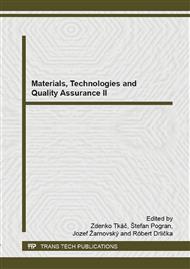[1]
L. L. Lucas, M. P. Unterweger, Comprehensive review and critical evaluation of the half-life of tritium, J. Res. Natl. Inst. Stand. Technol., 105(4) (2000) 541–549.
DOI: 10.6028/jres.105.043
Google Scholar
[2]
C. Varlam, I. Stefanescu, I. Faurescu, I. Vagner, D. Faurescu, D. Bogdan, Establishing routine procedure for environmental tritium concentration at ICITI, Rom. J. Phys., 56(1–2) (2011) 233–239.
DOI: 10.1080/15361055.2017.1289451
Google Scholar
[3]
M. J. Madruga, M. M. Sequeria, A. R. Gomes, Determination of tritium in waters by liquid scintillation counting, in: J. Eikenberg, M. Jaggi, H. Beer, H. Baehrle (Eds. ), LSC 2008, Advances in Liquid Scintillation Spectrometry, 2008, p.353–359.
Google Scholar
[4]
B. Bridges, Effectiveness of tritium beta particles, J. Radiol. Prot., 28 (2008) 1–3.
Google Scholar
[5]
M. P. Little, B. E. Lambert, Systematic review of experimental studies on the relative biological effectiveness of tritium, Radiat. Environ. Biophys., 47 (2008) 71–93.
DOI: 10.1007/s00411-007-0143-y
Google Scholar
[6]
M. P. Little, R. Wakeford, Systematic review of experimental studies on the relative biological effectiveness of tritium, J. Radiol. Prot., 28 (2008) 9–32.
Google Scholar
[7]
T. Pauliček, P. Čičo, J. Zaujec, M. Burda, Risk assessment and actions to reduction of risk in explosive environment, Management Systems in Production Engineering, 7(3) (2012) 18–20.
Google Scholar
[8]
J. Žitňanský, P. Polák, Rezné podmienky a ich vplyv na kvalitu produktu vzhľadom na ekologizáciu výroby, in: Quality, Technologies, Diagnostics of Technical Systems, SUA in Nitra, Nitra, 2013, p.176–180.
Google Scholar
[9]
J. Tomáš, R. Drlička, V. Kročko, Dry machining as alternative technology for environment protection improvement, Acta Technologica Agriculturae, 5(3) (2002) 80–82.
Google Scholar
[10]
STN EN ISO 14001: 2005. Environmental management certificate.
Google Scholar
[11]
J. Hrubec, E. Virčíková, Integrovaný manažérsky system, 1st ed., SUA in Nitra, Nitra, (2009).
Google Scholar
[12]
J. Žarnovský, V. Peťková, R. Drlička, J. Dobránsky, Air quality improvement by reduction of gas turbines emissions, Applied Mechanics and Materials, 308 (2013) 159–164.
DOI: 10.4028/www.scientific.net/amm.308.159
Google Scholar
[13]
J. Žarnovský, J. Žitňanský, I. Kováč, R. Mikuš, M. Šopor, Analýza výfukových plynov vo fáze zohrievania motora, in: DIAGO 2011 : technická diagnostika strojů a výrobných zařízení, Vysoká škola báňská – Technická univerzita, Ostrava, 2011, p.555.
DOI: 10.15584/eti.2018.4.48
Google Scholar
[14]
Information on: http: /www. seas. sk.
Google Scholar
[15]
P. Polák, J. Žitňanský, Integrované systémy riadenia, 1st ed., SUA in Nitra, Nitra, (2013).
Google Scholar
[16]
P. Jean-Baptiste, E. Fourré, The distribution of tritium between water and suspended matter in a laboratory experiment exposing sediment to tritiated water , Journal of Environmental Radioactivity, 116 (2013) 193–196.
DOI: 10.1016/j.jenvrad.2012.11.004
Google Scholar
[17]
G. J. Hunt, T. A. Bailey, S. B. Jenkinson, K. S. Leonard, Enhancement of tritium concentrations on uptake by marine biota: experience from UK coastal waters, J. Radiol. Prot., 30 (2010) 73–83.
DOI: 10.1088/0952-4746/30/1/n01
Google Scholar
[18]
M. Masson, F. Siclet, M. Fournier, A. Maigret, G. Gontier, P. Bailly du Bois, Tritium along the French coast of the English Channel, Radioprotection, 40 (2005) S621–S627.
DOI: 10.1051/radiopro:2005s1-091
Google Scholar
[19]
J. Nikolov, N. Todorovic, M. Jankovic, M. Vostinar, I. Bikit, M. Veskovic, Different methods for tritium determination in surface water by LSC, Applied Radiation and Isotopes, 71(1) (2013).
DOI: 10.1016/j.apradiso.2012.09.015
Google Scholar


